Oceana.
oceana.org
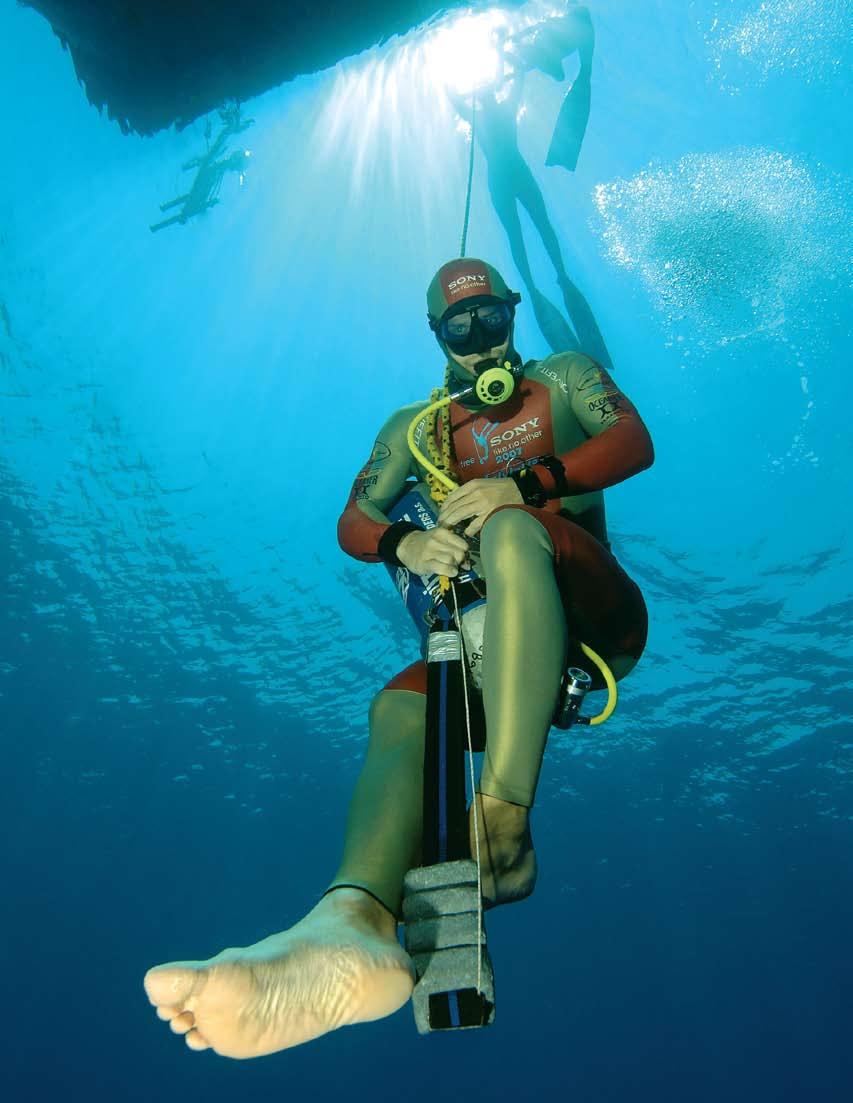
Plus More victories for sharks and sea turtles
SPRING 2008
Dive Free World champion diver Martin Stepanek joins Oceana Hold the Mercury Seafood in the U.S. may be more contaminated than you think
BOARD OF DIRECTORs
Herbert M. Bedolfe, III, Chair
Keith Addis, Vice Chair
Simon Sidamon-Eristoff, Secy. & Treas.
Ted Danson
César Gaviria
María Eugenia Girón
Stephen P. McAllister
Michael Northrop
Dr. Kristian Parker
Dr. Daniel Pauly
Sally-Christine Rodgers
James Sandler
Sam Waterston
OCEAN COuNCIl
Anne Alexander Rowley, Chair
Dr. Sharon Benjamin
Gerald Breslauer
Pierce Brosnan
Philippe Cousteau
April McClain-Delaney
Kelsey Grammer
Thomas Hansen
Lea Haratani
Hardy Jones
Barbara Kohn
Larry Kopald
George Lewis, Jr.
Drew Murphy
Dr. Wallace J. Nichols
Jimmy Olmes
Mark E. Ryavec
Josh Simcox
Victoria Stack
Peter Stranger
Bob Talbot Christiane Turner Karen White Annett Wolf
OCEANA
Chief Executive Officer Andrew Sharpless Executive Vice President and General Counsel Jim Simon
Senior Vice President for North America/Chief Scientist Michael Hirshfield, Ph.D.
Vice President for Europe Xavier Pastor
Vice President and Senior Advisor Jim Ayers
Vice President for Strategic Marketing and Communications Matthew Littlejohn
Vice President, Global Development Bettina Alonso
Vice President, Operations and CIO Romanus Berg
Director, Pacific Susan Murray
EDITORIAl sTAFF
Editor
Suzannah Evans
Graphic Design Team
Jaela Grayson Cory Wilson
MAKING WAVEs
s hark campaigns progress worldwide
Oceana’s international campaign to safeguard sharks continued to make progress around the world in early 2008.
In the United States, Oceana scored a victory when it convinced the Vermont Country Store to stop selling a skin enhancer containing squalane, a substance obtained from the livers of deep sea sharks. Ironically, the product name was “Oceana.”
Clarins, Sisley and La Mer (an Estée Lauder brand), which have disclosed that they either made the decision to stop using shark-based squalane or had a policy to never use it in the first place, according to information the European headquarters of these companies provided to Oceana.
In Chile, Oceana successfully promoted a national shark protection plan that calls for better regulation
Success in this effort was largely thanks to the help of thousands of online Wavemakers.
“Deep sea sharks grow slowly, and they are extremely vulnerable to overfishing,” said Elizabeth Griffin, a marine biologist with Oceana. “It’s simply wrong to let sharks disappear for the sake of personal beauty, especially when squalane can be made from alternatives like olives.”
In January, Oceana’s European office learned that Unilever intended to switch to plant-based squalane for its cosmetics. A multinational company, Unilever produces many brands including Dove and Pond’s. The company joins Beiersdorf, LVMH, Henkel, Boots,
of shark fishing and finning. In addition, the United Nations General Assembly called for stronger shark protections and management this year. This included, for the first time, a call for sharks to be landed whole with their fins still naturally attached.
“The geographical scope covered by the General Assembly member states and the new calls for shark management in the resolution on sustainable fisheries give an incredible chance for global shark conservation,” said Ricardo Aguilar, research director for Oceana Europe.
Learn more about Oceana’s efforts to safeguard sharks at www.oceana.org/sharks.

u. s . to review loggerhead situation
endangered under the Endangered Species Act. The U.S. government also will determine whether further habitat protections are warranted in the Atlantic.
The southeastern United States is home to the most important loggerhead nesting beaches in the western hemisphere, but nesting in this region is in decline. In Florida, loggerhead nesting has dropped 50 percent during the past decade.
“Loggerhead numbers have been in decline for too long,” said Dave Allison, director of Oceana’s campaign to save sea turtles. “They clearly need more protection than they’re receiving at this time.”
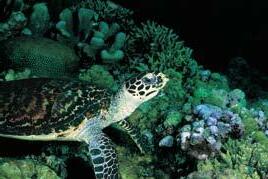
In response to a formal petition filed by Oceana and the Center for Biological Diversity, the U.S. government announced in March that it will conduct a detailed review of loggerhead sea turtle populations in the Atlantic Ocean to decide whether they should be uplisted from threatened to
The greatest threats facing loggerheads are capture in commercial fishing gear, beachfront development, pollution, motor vehicles crushing nests, collisions with boats, the hunting of turtles and their eggs, and climate change.
2 www.oceana.org
COVER PHOTO: Martin Stepanek © Petr Vaverka
Loggerhead turtle © OCEANA
Blacktip shark © OCEANA
Betting on Blue.
In an article titled “Betting on Green,” the Wall Street Journal reported that “venture capitalists are pouring money into clean energy companies.” These investors have concluded that there are jobs to be created and money to be made from an economy that sustainably manages the earth’s atmosphere.
What would it take to catalyze the same insight about our commercial ocean fisheries?
Science (December 7, 2007) published a paper showing that fishing sustainably increases profits to the commercial fishing industry. In other words, what we marine conservationists want is actually terrific for business.
Economists working at the Australian National University and at the University of Washington modeled tuna, prawn, and orange roughy fisheries and discovered that abundant fisheries are more profitable in every case. The reason is simple: The faster you catch your quota, the less money you spend on fuel and expenses, and the more money you take to the bank.
In other words, there is no conflict between marine conservation and a good strong commercial fishing industry.
Unfortunately, some commercial fishing companies are not actually fishing for fish – they’re fishing for taxpayer subsidies. Incentives are heavily distorted by the payment of more than $20 billion in capacitypromoting subsidies to the global commercial fishing industry. Given the depleted state of the world’s oceans – nearly a third of all commercial fisheries have already collapsed – many of these companies would not be profitable at all without the money they take in from taxpayers.
In February, researchers at the University of California-Santa Barbara’s National Center for Ecological Analysis and Synthesis unveiled a world map that demonstrated the extent of human activity in the oceans. By overlaying 17 different activities, including fishing, the researchers demonstrated that more than 40 percent of the world’s oceans are heavily affected by human activity, and that virtually no waters are still pristine.
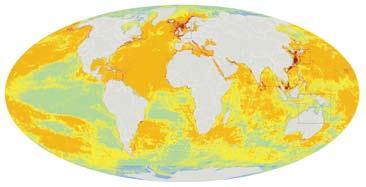
Taxpayer-supported fishing is a major factor in the decimation of the world’s oceans. The good news is that this tragic situation may be on the verge of being fixed. And the heroism comes from an unlikely source: the World Trade Organization (WTO). This
body sets the rules for international trade, and late in 2007 it published a draft text which would prohibit the subsidies that are driving ocean collapse.
Oceana praised the WTO’s proposed text as an essential step in restoring and protecting abundant oceans. Together with allies in the international science community and a broad coalition of environmental, consumer, and business interests, we are working to support a WTO outcome that stops paying companies to overfish. It seems possible that when the conservation history of this decade is written, the most important conservation victory for the oceans will have been written by scientificallygrounded diplomats and free traders in Geneva.
If the WTO carries through on eliminating the subsidies for overfishing, they will not only put more fish back into the sea, but they will put more profits into the pockets of the commercial fishing industry.
Not a bad picture, is it? It’s time to bet on blue at the WTO.
Sincerely,
 Andrew Sharpless Chief Executive Officer
Andrew Sharpless Chief Executive Officer
Scientists determined that less than four percent of the world’s oceans are still pristine.
Map courtesy the National Center for Ecological Analysis and Synthesis.
www.oceana.org 3 CEO’s note
© OCEANA | Cory Wilson
Q&A Martin stepanek
Martin Stepanek, 30, is one of the world’s stars in the emerging sport of free diving. Unaided by scuba tanks, he has broken several world records for depth and length of time underwater, including the record for holding his breath for eight minutes and six seconds. With a view of the underwater world unencumbered by diving equipment, Stepanek has a unique perspective on our changing oceans. He recently joined Oceana as a spokesman.
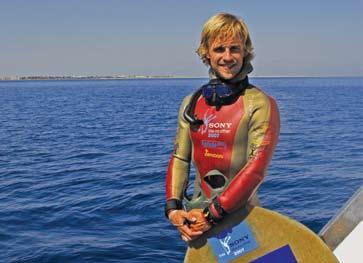
Learn more about Stepanek at www.martinstepanek.com, and read the complete transcript of his interview with Oceana at www.oceana.org/newsletter.
You’re from the Czech Republic, a landlocked country. How did you become interested in diving?
My mom used to be a competitive swimmer, so she wanted me to be a competitive swimmer as well. I knew how to swim before I knew how to walk. [When] I was about seven years old, I saw the local scuba diving club training in the pool. I was really impressed by those guys that were crawling on the bottom, and could stay underwater a pretty long time. So I told my mom, I want to be a diver. In Czechoslovakia back then, a communist country, it wasn’t like here with a dive shop. It was all in clubs that were supported with the government. In the summer, when there was no snow and ice outside like most of the year in the Czech Republic, we actually went out and we were diving. My favorite discipline was the 50-meter sprint, which was done underwater holding your breath. So doing these sprints since I was a kid I developed good breath hold without even knowing it. In the summer when we were out diving, I was the youngest kid in the club, and usually the older guys took my tanks. I ended up freediving anyway.
There’s a lot of potential dangers involved in free diving, such as blackout, loss of motor control, laryngospasms, free diver bends, lung contractions, and cardiac arrest. Do you ever worry about this stuff?
To me, it’s the purest way of connecting with the ocean ... The experience you’re having out of it is much more pure and more intense.
What makes you want to do free diving versus scuba diving?
I enjoy scuba diving as well; don’t get me wrong. I find a lot more freedom in free diving. To me, it’s the purest way of connecting with the ocean because you don’t wear any extra equipment that separates you from the environment. Therefore the experience you’re having out of it is much more pure and more intense. Also, the world around you, the animals you encounter on a free dive, they allow you to get much closer to them because they are not afraid of you, they’re thinking you’re one of them, they respect you much more.
No, actually I don’t worry about it that much because I understand where this is coming from and how it is happening. Unfortunately our sport’s getting a little bit of a bad name; people perceive it as a really dangerous sport. I’ve heard it called the oldest extreme sport in the world. It’s all a little bit misleading. Actually all these things that you just mentioned can happen on a scuba dive as well. The thing about free diving is there’s certain rules you need to follow, just like driving a car or when you scuba dive. When you follow them, the sport is relatively safe. When you look at the statistics of death and injury, we are far behind many normal sports or activities. The problem is when people don’t follow the rules, the very basic safety precautions that are not very difficult or challenging to follow, we don’t have any grey area. You either live or you don’t at the end. If somebody is dumb enough to go out and free dive by himself, hyperventilates and stuff like that, yes, it can be dangerous. I would call it the same as Russian roulette.
What would you say to someone who’s a scuba diver who’s interested in trying free diving? How can they get started?
I think the best way and the right way is to take a class. There’s certain rules that need to be followed, and you get the knowledge from someone who’s a legitimate teacher. That would be the best way to do it. I think scuba divers will be amazed with how much it helps them with their scuba diving – air consumption, streamlining, enjoying the dive, feeling more secure and more confident because
4 www.oceana.org
PHOTOS: © Petr Vaverka
when you can free dive 100 feet, and then you scuba dive 100 feet, then you feel much more secure than when you’re thinking, maybe my tank or something will fail, what will I do? Well, I’ll hold my breath until I fix it. You figure out the solution. People are much calmer and better divers after that.
While you’ve been diving, have you noticed any changes in what you’re seeing over the years? What is it that you see under the water that you really want to preserve for the future?
The changes are incredible. It’s heartbreaking and it’s really sad.The locations that I’ve been diving 10 years ago and diving them now, they’re not the same. There’s so many less fish, and the coral reef looks totally different. It’s heartbreaking, literally. Unfortunately it applies everywhere I go. I dive all around the world and it’s not just one spot. I’m living in south Florida, but I travel quite a bit. That’s something that I’ve observed pretty much everywhere.
If we go to my backyard, that’s a local beach here. That’s where we used to go free dive quite often, a beautiful reef with a lot of fish in it. What you see now, it’s just the reef. If there’s any fish on it, they’re very skittish, very small. You don’t see groupers anymore. There used to be a lot of groupers. You don’t see snappers there either, and there used to be a lot of snappers. It’s all gone.
What made you want to partner with Oceana?
Actually the way I find out about Oceana was my girlfriend was roaming the internet and she found the website. She said, wow, these are cool guys and you probably want to read about that. We had a lot of discussion on the ocean and conservation topics, and she noticed many times we were disappointed by how certain organizations are actually acting in this matter. When I read what Oceana did, how they tried to pursue their goal, what they do and what they achieve, I was so impressed. I thought, well, maybe there is something I can do to support these guys. Most of the free divers, because of the experience of free diving is so much more intimate than scuba diving, so they’re all conservation-mindset people. I see that I could deliver the Oceana message to them.
Martin Stepanek has broken eleven world records for free diving, sometimes surpassing records he set himself.The sport includes several disciplines, including diving with or without weights and fins. He is based in Ft. Lauderdale, Fla.

TAINTED Tu NA
What’S
Eating fish in a healthy way doesn’t have to be as complex as an intricate sushi roll. Oceana’s new report, Hold the Mercury: How to Avoid Mercury When Buying Fish, clears up the confusion.
Now, more than ever, consumers have a choice of seafood from around the globe: swordfish from South Africa, salmon from Alaska, tilapia from Honduras.
Rarely, however, can consumers find correct information about mercury in fish in a grocery store, market or restaurant. The U.S. Food and Drug Administration recommends that women of childbearing age and young children do not eat four high-mercury fish species: swordfish, shark, tilefish and king mackerel. In addition, the FDA recommends limiting consumption of albacore tuna or tuna steaks to six ounces or less each week, and limiting low-mercury fish to 12 ounces or less per week.
Mercury contamination can damage critical organs of the central nervous and cardiovascular systems. The developing nervous system of infants and children are particularly sensitive to excessive mercury exposure and may lead to problems with attention span, language, visual-spatial skills, memory and coordination.
Now, thanks to Oceana’s campaign, nearly 30 percent of grocery stores nationwide voluntarily post the FDA’s advice on signs at seafood counters. These stores have become part of Oceana’s Green List; those that haven’t are on the Red List. An interactive version of both lists is available at www.oceana.org/gl/.
Still, a majority of grocers do not post the mercury advisory. So how can consumers find out about mercury in seafood?
Salmon (farmed) 0.014 2.650b
Mackerel (North Atlantic) 0.05 2.390c
Herring 0.044 2.055b,c
Anchovies 0.043 1.973b,c
Salmon (canned) <0.01 1.960c
Salmon (wild) 0.014 1.880b,c
Tuna (canned, light) 0.118 1.600c
Sardines 0.016 0.982b
Pollock 0.041 0.540d
Crab (blue, king, snow) 0.06 0.420d
Scallop 0.05 0.370b
Shrimp <0.01 0.310d
Flatfish (sole, flounder, plaice) 0.045 0.189c
Catfish 0.049 0.180d
Cod 0.095 0.150d
Tilapia 0.01 0.110d
Fish serve as an excellent low-fat source of protein. Many health benefits, such as decreased risk for cardiovascular disease, have been associated with the omega-3 fatty acids found in fish. Oceana has identified some fish that are both low in mercury and high in omega-3.
In Hold the Mercury: How to Avoid Mercury While Buying Fish, Oceana sent staff and volunteers to 40 seafood counters across the United States to ask one question: “What is the government advice on mercury in seafood for women who are thinking about having kids?” Only 13 percent of the responses correctly explained the FDA health warning. The other responses were all over the map: from ignorance of the mercury issue entirely to advice to eat large cherrystone clams if the woman in question wanted a baby boy, and smaller clams for a girl.
In addition to asking questions, Oceana staff and volunteers collected fish samples from 26 U.S. cities and analyzed them for mercury. Average mercury concentration in the tested grocery store tuna was .68 parts per million (ppm), nearly double the level in FDA data, which showed average concentration at .38 ppm for fresh or frozen tuna. Oceana found sushi tuna to be even higher, with an average value of .86 ppm.
In a separate study commissioned by The New York Times and released the same week as Hold the Mercury, mercury in sushi from upscale restaurants in New York was well above the FDA’s average. Sushi from Nobu Next Door tested at 1 ppm for mercury, and Blue Ribbon Sushi featured the highest level tested at 1.4 ppm.
The confluence of the study from The Times with Oceana’s led to renewed nationwide interest in the mercury issue. Oceana’s study was featured in a follow-up story in The Times, as well as other national newspapers, The Today Show and National Public Radio.
6 www.oceana.org
Fatty
sPECIEs
(g/100
In StOreS and reStaurantS, Mercury IS
FOr dInner Many Low-Mercury Fish are High in Omega-3
Acids, EPA and DHA
AVERAGE MERCuRy CONCENTRATION (PPM)a TOTAl OMEGA-3
g)
The FDA can remove fish with mercury contamination above 1 ppm from market, but it never does even though the prevalence of highly contaminated fish seems to be increasing. One in three of the sushi tuna samples tested by Oceana exceeded the FDA action level. Despite these findings, however, fresh tuna, like that found in sushi, is not included in the FDA’s “Do Not Eat” advice.
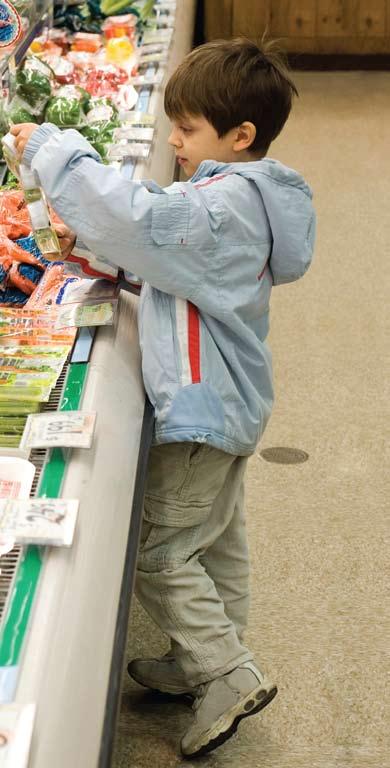
“Shoppers have a right to know about the government mercury warning, and it’s up to grocers to make it available,” said Jackie Savitz, director of Oceana’s campaign to end seafood contamination. “While we now have 28 grocery store chains posting signs, many people are still not getting this information because they shop at Red List stores like Costco, Publix and A&P.”
Two years after the FDA announced the consumer advisory, the Center for Science in the Public Interest found that 31 percent of pregnant women, women planning to become pregnant and nursing mothers were unaware that high-mercury seafood could be harmful. At the same time, another 18 percent of fish consumers may have misunderstood the advice and unnecessarily reduced their fish intake. Fish is an excellent source of low-fat protein and the omega-3 fatty acids found in fish have been associated with improved cardiovascular health. (See table on left for examples.)

“Oceana’s new report aims to simplify the issue,” Savitz said. “We want people to continue to enjoy low-mercury fish, which they can easily do if they’re aware of the fish most affected by mercury contamination.”



The report is part of Oceana’s larger campaign to educate consumers and to end mercury pollution. A major source of mercury is outdated technology in chlorine plants that emit mercury into the air and waterways. In three years, Oceana has convinced five of the remaining nine chlorine plants in the United States to stop using mercury technology, since mercury-free technology is available and used by more than ninety percent of the industry.

Guide to Ocean Friendly SEAFOOD
A handy pocket guide to seafood from Oceana and the Blue Ocean Institute can help you decide what fish is good for you no matter where you are. A copy of the guide is included in this issue.
Mercury contamination can be particularly harmful to the developing nervous system of infants and children, adversely affecting attention span, language, visual-spatial skills, memory and coordination. Despite evidence that mercury levels in some seafood exceeds the FDA’s action level, less than 30 percent of grocery store chains post the government advisory on mercury contamination.
Victoria Stack is a settled Washington, D.C. resident these days, but the Louisiana native has lived in some of the world’s farflung places. As the daughter of a civil engineer with the Army Corps of Engineers, she spent her youth in cities like Tehran and Rangoon. Now, she’s a leading advocate for several international environmental and animal welfare organizations. She credits her years abroad for turning her into the advocate she is today.
“It led into all of the later passion I had for global issues,” she said.
Stack was introduced to Oceana by Ocean Council Chair Anne Alexander Rowley. The two were members of Rachel’s Network, a group for women in conservation. A member of the Ocean Council now, Stack is especially dedicated to ocean issues and credits her awakening to a sailing trip in the British Virgin Islands her family had taken years earlier. The beautiful view and fresh ocean air belied the threats facing the ocean.
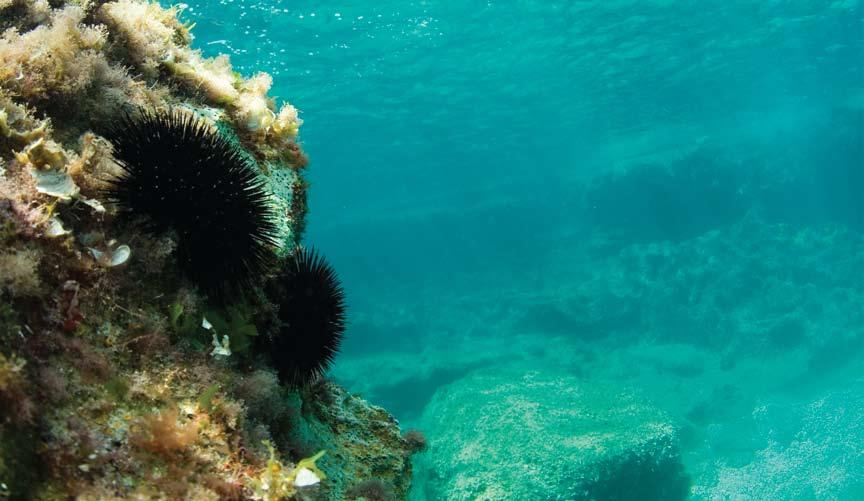
“I came from enjoying the ocean’s serenity and sleeping under the stars, confident of the ocean’s bounty,” Stack said. “Then, I had no idea the ocean was in such peril.”
Today, Stack finds a spiritual element in her advocacy in addition to the practical reasons for protecting the ocean ecosystem. “We all live here on this little blue planet in a very interconnected and mutually dependant way, and, being conscious of this, I feel humankind will benefit morally, ethically, and spiritually in preserving the ocean’s incredibly beautiful bounty,” she said.

MA KE WAV ES. G ET WE T.
Oceana ha s joined forces with Sperry Top-Sider to promot e marine cons er va tion. A le ader in naut ical lifest yl e and performance foot we ar, Sperry Top-Sider wi ll aid Oceana in it s ef fort s to expand the consti tuency for the oceans
Oceana wi ll be come the of f ici al char it y part ner of the Sperry Top-Sider NOOD Rega tt as, the largest single rega tta series in the Unit ed St at es. In addi tion, Sperry Top-Sider will re ach out to it s cust omer base of ocean-lov ing sailors and ot her fans of the seas to join Oc eana and suppor t it s ef fort s as new Wa vema kers
“This is a cr it ical juncture for our world’s oceans,” sa id Ka ren Pi tt s, vice president of market ing for Sperry Top-Sider. “As a br and wi th a 72-year heri tage ti ed dire ct ly to enjoying life in, on and around the wa ter, we’re de eply commit ted to suppor ting Oceana in it s crusade to prot ect one of our eart h’s most precious assets.”
8 www.oceana.org
DONOR PROFIlE
+
Protecting the World’s Oceans
sperrytopsider .com
Ocean Council member Victoria Stack has a natural affinity for the oceans.
A ‘ sEA C HANGE ’ IN C A l IFORNIA
On Dec. 23, guests gathered at the Laguna Beach, California home of Oceana supporters David and Valarie Whiting. The party kicked off the countdown to Sea Change, a star-studded fundraiser honoring John Picard, Harrison Ford and Sam Waterston. Sea Change will take place on July 18 at the Cahill Estate in Laguna Beach. The event is co-chaired by Valarie Whiting and Julie Hill.
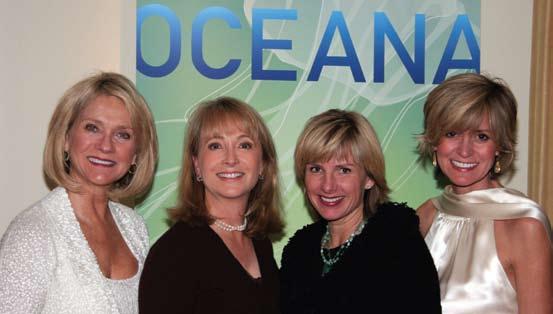
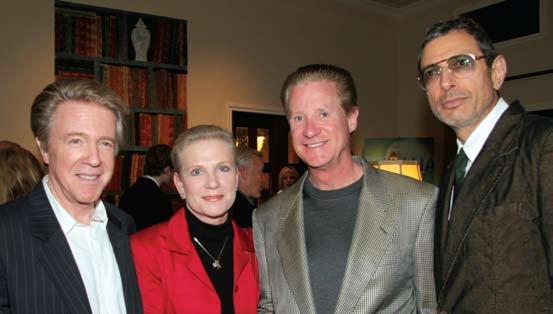
Guests at the Whiting home included Academy Award nominated actor Jeff Goldblum, Oceana vice chairman and producer Keith Addis, and British Consul General Bob Peirce, who was a key figure in brokering a climate change cooperation agreement

between former U.K. Prime Minister Tony Blair and Governor Arnold Schwarzenegger.
“We are fortunate to live in beautiful Southern California. We benefit greatly from the beaches and Pacific Ocean that are at our front door,” said Valarie Whiting. “Even so, we may forget that oceans cover 71 percent of the earth’s surface and they are a major source of protein for more than a third of the world. We know that there is a collective desire in Orange County to be part of the solution to the problems that plague California’s coastline and the world’s oceans.”
www.oceana.org 9
Sea Change co-chairs Julie Hill and Valarie Whiting, from left, with Elizabeth Healey and Nancy Christiano.
Oceana vice chairman Keith Addis, Oceana supporters Karen and Bruce Cahill, and actor Jeff Goldblum.
PHOTOS: © Elizabeth Healey
Chef Peter Hoffman’s
Savoy is located in the bustling SoHo neighborhood of Manhattan, but the restaurant offers something unexpected: a rustic interior that’s home to some of the city’s most ecologically responsible fine dining. Hoffman is a board member of Chef’s Collaborative, an organization dedicated to helping chefs make sustainable choices.
“As a chef and a resident of planet earth, I’m inspired by the diversity of flavors and cuisines found around the globe, particularly in the realm of
seafood,” said Hoffman. “I don’t want to participate in the squandering of those resources or in the creation of cultural or biological monocultures. So as a restaurant, we source ingredients that have been thoughtfully produced and gathered with the palates and pleasures of our children and grandchildren in mind as well as our own today.”
Savoy offers a seasonal menu based on local and sustainable ingredients. For more information, visit savoynyc.com, his second restaurant Back Forty located in New York’s East Village (www.backfortynyc.com) and www.chefscollaborative.org.

3-4 oz striped bass per person
3 Taylor Bay scallops or little neck clams per person
¾ cup of savoy cabbage cut in 1” strips ¼ cup Jerusalem artichokes cut in ½” cubes or fingerling potatoes
2 oz vegetable or fish stock 1 tablespoon white wine gremolata butter ¼ cup butter softened 1 small clove garlic 2 tablespoons roughly chopped parsley 2 teaspoon lemon zest 1 teaspoon orange zest
Be an Eco-Friendly Consumer
Organic Style Magazine is a quarterly online publication connecting you to environmentalists, humanitarians, growers and artisans who make it their mission to put the planet first. Get a first-hand look at the inspiring stories and timely tips that will help you live a more eco-friendly lifestyle. Sign up for a complimentary subscription at www.organicstyle.com/oceanaosmag and get a coupon good for $10 off your next OrganicStyle.com purchase plus a 10 percent donation to Oceana.
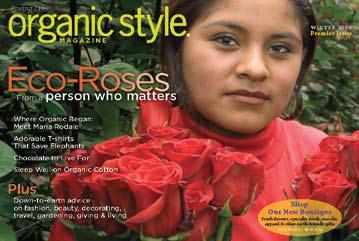
To receive the coupon, enter this code: OCEANAOSMAG. Expires June 6, 2008.
Combine all ingredients and add salt to taste. Hold until ready for final preparation.
Briefly sauté the cabbage and the artichoke pieces in a pan with some olive oil. Add the stock and the wine and cover. Simmer for 8 minutes. Meanwhile heat a sauté pan. Add some olive oil and sear the pieces of bass skin side down first. When they are golden brown, turn them over and place in the oven for 5 minutes to complete the cooking. Add the scallops to the vegetable pot and cover again. Cook 2 minutes or until the scallops open up. Remove the scallops and add a pad of the butter and swirl into the broth. Place the vegetables in a bowl. Set the fish on top. Sprinkle with a little more of the herb and zest mix and serve.
10 www.oceana.org
Str I ped ba SS and taylO r b ay S callO p S w ITH B r AISED CABBAGE AND G r EMOLATA B u TTE r
CHEF’s CORNER
Corals are the guardians of the sea. While they cover just one percent of the ocean floor, they create homes for a quarter of the world’s marine life. Colorful corals, like the golden cup and the red gorgonian, flourish in Mediterranean waters near Spain. Destructive fishing techniques like bottom trawling can destroy centuries-old reefs in an instant. Oceana celebrates International Year of the Reef in 2008, and continues to work to protect the guardians of the sea.

sHOT
PARTING
© OCEANA | Juan Cuetos
Oceana campaigns to protect and restore the world’s oceans. Our team of marine scientists, economists, lawyers and advocates win specific and concrete policy changes to reduce pollution and to prevent the irreversible collapse of fish populations, marine mammals and other sea life. Global in scope and dedicated to conservation, Oceana has campaigners based in North America, Europe and South America. More than 300,000 members and e-activists in over 150 countries have already joined Oceana. For more information, please visit www.oceana.org.
Oceana’s accomplishments wouldn’t be possible without the support of its members. You can help Oceana fight to restore our oceans with your financial contribution. Call us today at 1.877.7.OCEANA, go to our Web site www.oceana.org/give and click on “give today” or use the envelope provided in this newsletter. You can also invest in the future of our oceans by remembering Oceana in your will. Please contact us to find out how. All contributions to Oceana are tax deductible. Oceana is a 501 (c) (3) organization as designated by the Internal Revenue Service.
Oceana’s Privacy Policy: Your right to privacy is important to Oceana, and we are committed to maintaining your trust. Personal information (such as name, address, phone number, e-mail) includes data that you may have provided to us when making a donation or taking action as a WaveMaker on behalf of the oceans. This personal information is stored in a secure location. Credit-card donations through the Web site are made via a secure server. Like other non-profits, Oceana may make contact information (not including e-mail addresses) available to other organizations we believe may be of interest to our members and supporters. If you would like to review the information in our files, correct it, or ask Oceana to refrain from sharing your contact information with other organizations, please contact us by writing us an e-mail at info@oceana.org, by calling Oceana’s membership department at +1.202.833.3900, or by writing to us at Oceana Member Services, 1350 Connecticut Ave. NW, 5th Floor, Washington, D.C. 20036. We will be happy to accommodate your request.
1350 Connecticut Ave. NW, 5th Floor Washington, DC 20036 phone: +1.202.833.3900 toll-free: 1.877.7.OCEANA
Protecting the Wo rld’s Oceans
Oceana is published by Oceana Inc. For questions or comments about Oceana, or to subscribe to Oceana, please call Oceana’s membership department at +1.202.833.3900, e-mail membership@oceana.org or write Oceana, Member Services, 1350 Connecticut Ave. NW, 5th Floor, Washington, D.C. 20036, USA.

ABO u T OCEANA
Give today! Printed
Global | Washington, DC Europe | Brussels | Madrid North America | Anchorage | Boston | Juneau | Monterey | New York | Portland | St. Petersburg South America | Santiago WE’VE MOVED! Please update your records!
with Eco-Ink — low volatility vegetable oil-based ink on 25% postconsumer recycled, processed chlorine free paper produced using 100% wind power in a carbon neutral process.
© OCEANA | Juan Cuetos





 Andrew Sharpless Chief Executive Officer
Andrew Sharpless Chief Executive Officer










